load capacity Alfa Romeo 156 2004 Owner handbook (in English)
[x] Cancel search | Manufacturer: ALFA ROMEO, Model Year: 2004, Model line: 156, Model: Alfa Romeo 156 2004Pages: 357, PDF Size: 5.04 MB
Page 178 of 357

GETTING TO KNOW YOUR CAR
176
The electromechanical system to auto-
matically keep constant trim makes the
headlight tilt compensating device unnec-
essary.
The xenon lamps have very long life which
makes possible fault very unlikely.
If necessary, have the sys-
tem checked and repairs (if
any) made only by Alfa Romeo Au-
thorized Services.
WARNING
GAS DISCHARGE HEADLIGHTS(optional for versions/markets
where applicable)
The gas (xenon) discharge headlights op-
erate with a voltaic arc, in an ambient sat-
urated with pressure xenon, instead of the
glow filament.
The resulting illumination is sensibly higher
to that of conventional lamps, both for light
quality (clearer light) and for the width and
positioning of the illuminated area.
The advantages of better illumination can
be perceived (due to less eyesight fatigue
and greater orientation capacity for the dri-
ver, which in turn means higher driving
safety) especially in case of bad weather,
fog and/or insufficient road signs, thanks
to the better illumination of the side parts
of the visual field, normally obscured.The large increase of the side part illumi-
nation increases driving safety since it allows
the driver to better see the other users on
the edge of the road (pedestrians, cyclists
and bikers).
The triggering of the voltaic arc requires a
very high voltage, while subsequent power
supply can take place at a low voltage.
The headlights achieve their top luminos-
ity approx. 15 seconds after they are
switched on.
The intense light produced by this type of
headlights requires the use of an automatic
system to keep headlight trim constant and
avoid dazzling the vehicles coming from the
opposite direction in case of braking, accel-
eration or when carrying loads.
Page 201 of 357

CORRECT USE OF THE CAR
199
TOWING TRAILERSWARNINGS AND
SUGGESTIONS For towing caravans or trailers the vehi-
cle must be fitted with a certified tow hook
and an adequate electric system. Installa-
tion should be carried out by specialised per-
sonnel who release a special document for
circulation on the road.
Install any specific and/or additional rear-
view mirrors as specified by law. Remember
that when towing a trailer, steep hills are
harder to climb, the braking spaces increase
and overtaking takes longer depending on
the overall weight.
Engage a low gear when driving downhill,
rather than constantly using the brake.
The weight the trailer exerts on the vehi-
cle tow hook reduces by the same amount
the actual vehicle loading capacity. To make sure the maximum towable
weight is not exceeded (given in the log
book) account should be taken of the fully
laden trailer, including accessories and per-
sonal belongings.
Drive within the permitted speed limits for
vehicles with trailers. In any case the maxi-
mum speed should never exceed 100 km/h.
INSTALLING THE TOW HOOKThe towing device should be fastened to
the body by specialised personnel according
to the following instructions and any addi-
tional and/or integrative information sup-
plied by the Manufacturer of the device.
The towing device must meet current reg-
ulations with reference to 94/20/EC Di-
rective and subsequent amendments.
For any version the towing device used
must match the towable weight of the ve-
hicle on which it is to be installed.
For the electric connection a unified con-
nector should be used which is generally
placed on a special bracket normally fas-
tened to the towing device.
The ABS system with
which the car may be fitted
does not control the trailer braking
system. Particular care is therefore
necessary on slippery surfaces.
WARNING
Under no circumstances
should the vehicle brake
system be altered to control the
trailer brake. The trailer braking
system must be fully independent
of the vehicle’s hydraulic system.
WARNING
Page 271 of 357
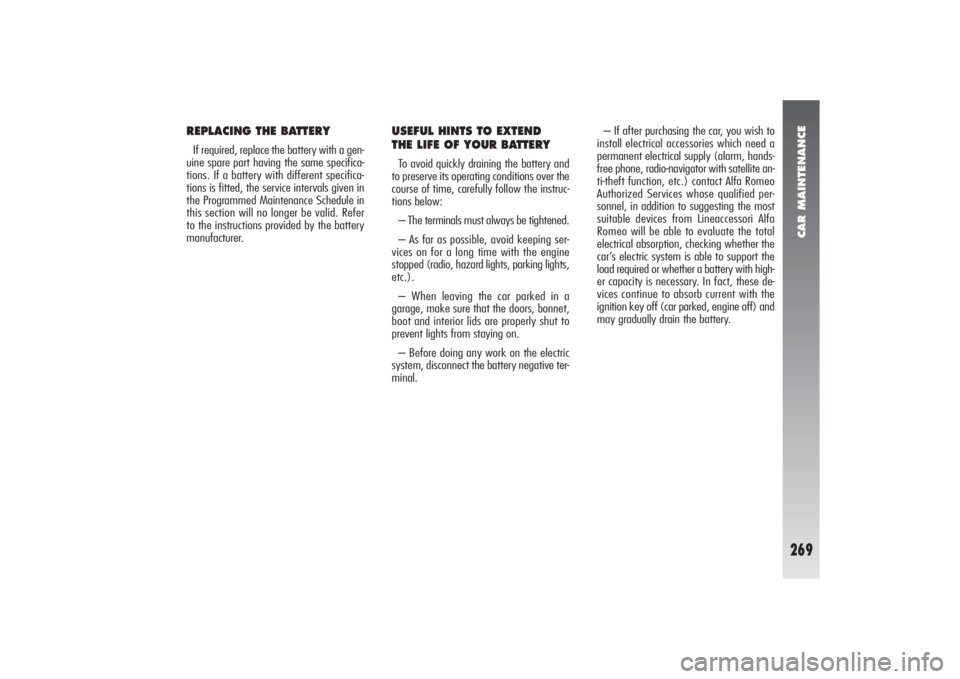
CAR MAINTENANCE
269
USEFUL HINTS TO EXTEND
THE LIFE OF YOUR BATTERYTo avoid quickly draining the battery and
to preserve its operating conditions over the
course of time, carefully follow the instruc-
tions below:
– The terminals must always be tightened.
– As far as possible, avoid keeping ser-
vices on for a long time with the engine
stopped (radio, hazard lights, parking lights,
etc.).
– When leaving the car parked in a
garage, make sure that the doors, bonnet,
boot and interior lids are properly shut to
prevent lights from staying on.
– Before doing any work on the electric
system, disconnect the battery negative ter-
minal.– If after purchasing the car, you wish to
install electrical accessories which need a
permanent electrical supply (alarm, hands-
free phone, radio-navigator with satellite an-
ti-theft function, etc.) contact Alfa Romeo
Authorized Services whose qualified per-
sonnel, in addition to suggesting the most
suitable devices from Lineaccessori Alfa
Romeo will be able to evaluate the total
electrical absorption, checking whether the
car’s electric system is able to support the
load required or whether a battery with high-
er capacity is necessary. In fact, these de-
vices continue to absorb current with the
ignition key off (car parked, engine off) and
may gradually drain the battery.
REPLACING THE BATTERYIf required, replace the battery with a gen-
uine spare part having the same specifica-
tions. If a battery with different specifica-
tions is fitted, the service intervals given in
the Programmed Maintenance Schedule in
this section will no longer be valid. Refer
to the instructions provided by the battery
manufacturer.
Page 295 of 357
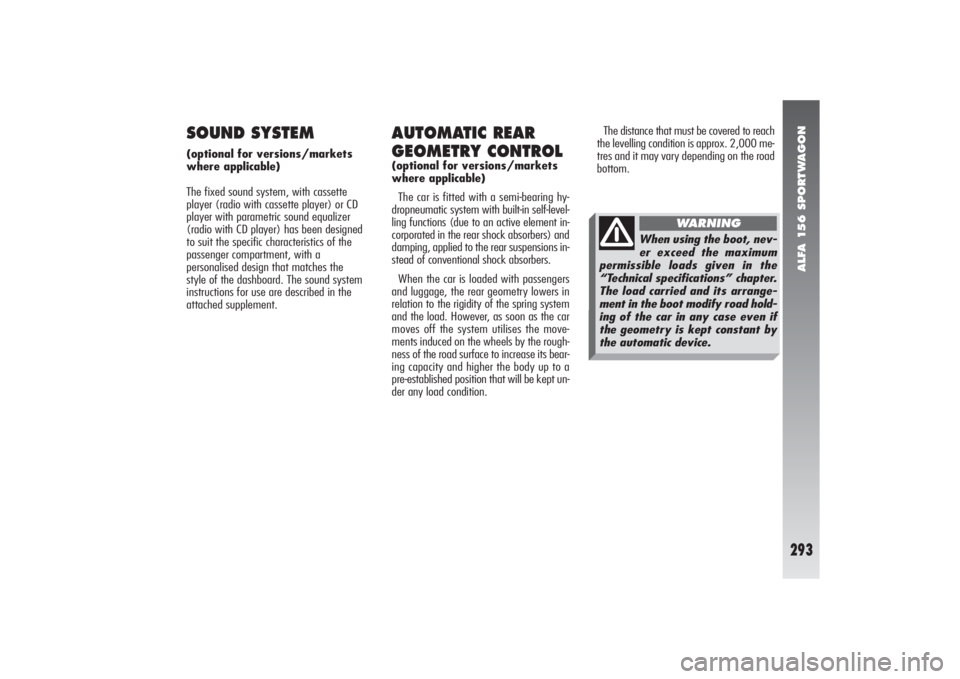
ALFA 156 SPORTWAGON
293
AUTOMATIC REAR
GEOMETRY CONTROL(optional for versions/markets
where applicable)
The car is fitted with a semi-bearing hy-
dropneumatic system with built-in self-level-
ling functions (due to an active element in-
corporated in the rear shock absorbers) and
damping, applied to the rear suspensions in-
stead of conventional shock absorbers.
When the car is loaded with passengers
and luggage, the rear geometry lowers in
relation to the rigidity of the spring system
and the load. However, as soon as the car
moves off the system utilises the move-
ments induced on the wheels by the rough-
ness of the road surface to increase its bear-
ing capacity and higher the body up to a
pre-established position that will be kept un-
der any load condition.
SOUND SYSTEM(optional for versions/markets
where applicable)
The fixed sound system, with cassette
player (radio with cassette player) or CD
player with parametric sound equalizer
(radio with CD player) has been designed
to suit the specific characteristics of the
passenger compartment, with a
personalised design that matches the
style of the dashboard. The sound system
instructions for use are described in the
attached supplement.The distance that must be covered to reach
the levelling condition is approx. 2,000 me-
tres and it may vary depending on the road
bottom.
When using the boot, nev-
er exceed the maximum
permissible loads given in the
“Technical specifications” chapter.
The load carried and its arrange-
ment in the boot modify road hold-
ing of the car in any case even if
the geometry is kept constant by
the automatic device.
WARNING
Page 313 of 357

TECHNICAL SPECIFICATIONS
311
CORRECT TYRE READING(fig. 5)
Below are the instructions necessary to
know the meaning of the code stamped on
the tyre.
The code may be like one of the examples
given below.Load index (capacity)
60= 250 kg
61= 257 kg
62= 265 kg
63= 272 kg
64= 280 kg
65= 290 kg
66= 300 kg
67= 307 kg
68= 315 kg
69= 325 kg
70= 335 kg
71= 345 kg
72= 355 kg
73= 365 kg
74= 375 kg
75= 387 kg
76= 400 kg
77= 412 kg
78= 425 kg
79= 437 kg
80= 450 kg
81= 462 kg
82= 475 kg
83= 487 kg84= 500 kg
85= 515 kg
86= 530 kg
87= 545 kg
88= 560 kg
89= 580 kg
90= 600 kg
91= 615 kg
92= 630 kg
93= 650 kg
94= 670 kg
95= 690 kg
96= 710 kg
97= 730 kg
98= 750 kg
99= 775 kg
100= 800 kg
101= 825 kg
102= 850 kg
103= 875 kg
104= 900 kg
105= 925 kg
106= 950 kg
Example:
205/60 R 15 91V
or:
215/45 ZR 17
205= Nominal width (S, distance
in mm between the sides).
60= Percentage height/width (H/S)
ratio.
R= Radial tyre.
ZR= Radial tyre with speed above
240 kph.
15= Rim diameter in inches. (Ø).
91= Load index (capacity), e.g. 91 =
615 kg. Not present in ZR tyres.
V, Z= Maximum speed index. In ZR tyres
the speed index Z is before the R.
fig. 5
A0B0395m
Page 319 of 357
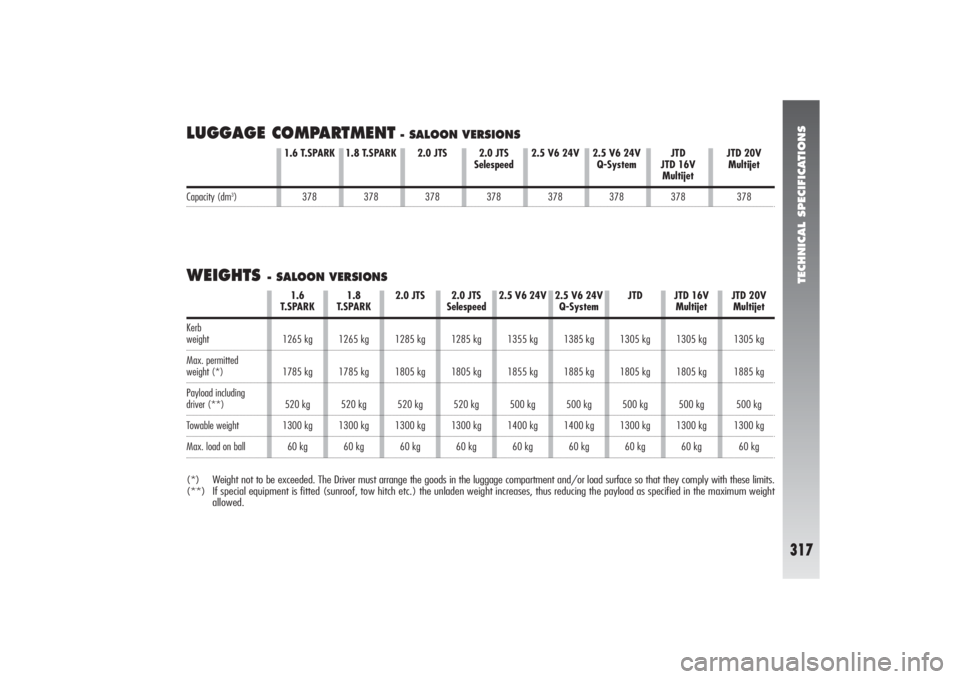
TECHNICAL SPECIFICATIONS
317
LUGGAGE COMPARTMENT
- SALOON VERSIONS
WEIGHTS
- SALOON VERSIONS
1.6 T.SPARK
378
1.8 T.SPARK
378
2.0 JTS
Selespeed378
2.5 V6 24V
378
2.5 V6 24V
Q-System
378
JTD
JTD 16V
Multijet378
JTD 20V
Multijet378
2.0 JTS 378
Capacity (dm
3)
1.6
T.SPARK1265 kg
1785 kg
520 kg
1300 kg
60 kg
1.8
T.SPARK1265 kg
1785 kg
520 kg
1300 kg
60 kg
2.0 JTS
Selespeed1285 kg
1805 kg
520 kg
1300 kg
60 kg
2.5 V6 24V1355 kg
1855 kg
500 kg
1400 kg
60 kg
2.5 V6 24V
Q-System1385 kg
1885 kg
500 kg
1400 kg
60 kg
JTD1305 kg
1805 kg
500 kg
1300 kg
60 kg
JTD 16V
Multijet1305 kg
1805 kg
500 kg
1300 kg
60 kg
JTD 20V
Multijet1305 kg
1885 kg
500 kg
1300 kg
60 kg
2.0 JTS 1285 kg
1805 kg
520 kg
1300 kg
60 kg
Kerbweight
Max. permitted weight (*)
Payload includingdriver (**)Towable weightMax. load on ball(*) Weight not to be exceeded. The Driver must arrange the goods in the luggage compartment and/or load surface so that they comply with these limits.
(**) If special equipment is fitted (sunroof, tow hitch etc.) the unladen weight increases, thus reducing the payload as specified in the maximum weight
allowed.
Page 320 of 357
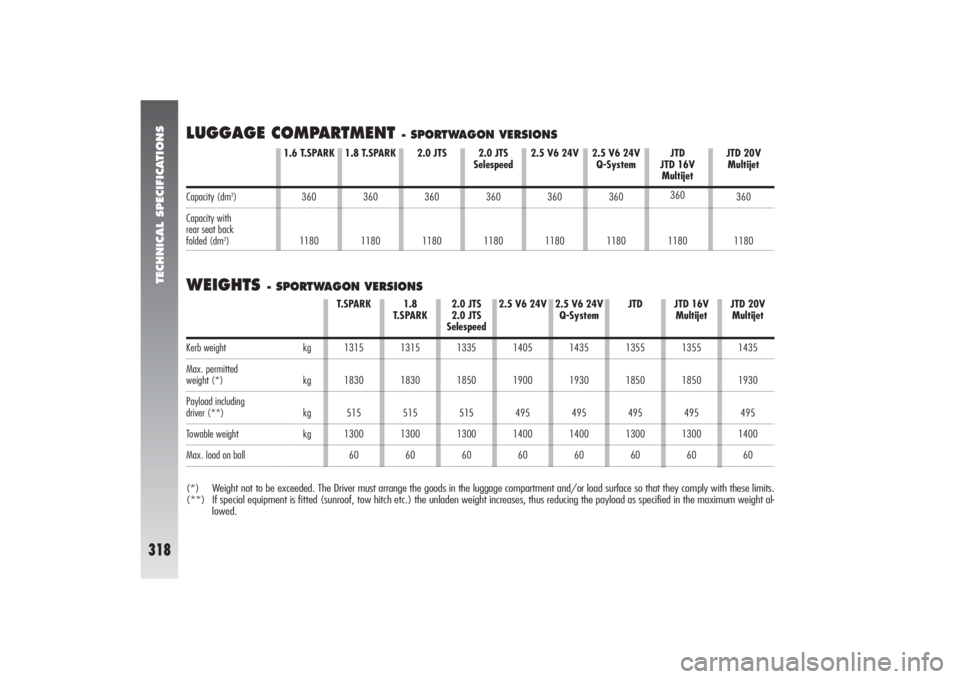
TECHNICAL SPECIFICATIONS
318
WEIGHTS
- SPORTWAGON VERSIONS
LUGGAGE COMPARTMENT
- SPORTWAGON VERSIONS
1.6 T.SPARK
360
1180
1.8 T.SPARK
360
1180
2.0 JTS
Selespeed360
1180
2.5 V6 24V
360
1180
2.5 V6 24V
Q-System
360
1180
JTD
JTD 16V
Multijet360
1180
JTD 20V
Multijet360
1180
2.0 JTS 360
1180
Capacity (dm
3)
Capacity with
rear seat back
folded (dm
3)
T.SPARK1315
1830
515
1300
60
1.8
T.SPARK1315
1830
515
1300
60
2.5 V6 24V
1405
1900
495
1400
60
2.5 V6 24V
Q-System
1435
1930
495
1400
60
JTD1355
1850
495
1300
60
JTD 16V
Multijet1355
1850
495
1300
60
JTD 20V
Multijet1435
1930
495
1400
60
2.0 JTS
2.0 JTS
Selespeed1335
1850
515
1300
60
Kerb weight kg
Max. permitted weight (*) kg
Payload includingdriver (**) kgTowable weight kgMax. load on ball(*) Weight not to be exceeded. The Driver must arrange the goods in the luggage compartment and/or load surface so that they comply with these limits.
(**) If special equipment is fitted (sunroof, tow hitch etc.) the unladen weight increases, thus reducing the payload as specified in the maximum weight al-
lowed.
Page 328 of 357
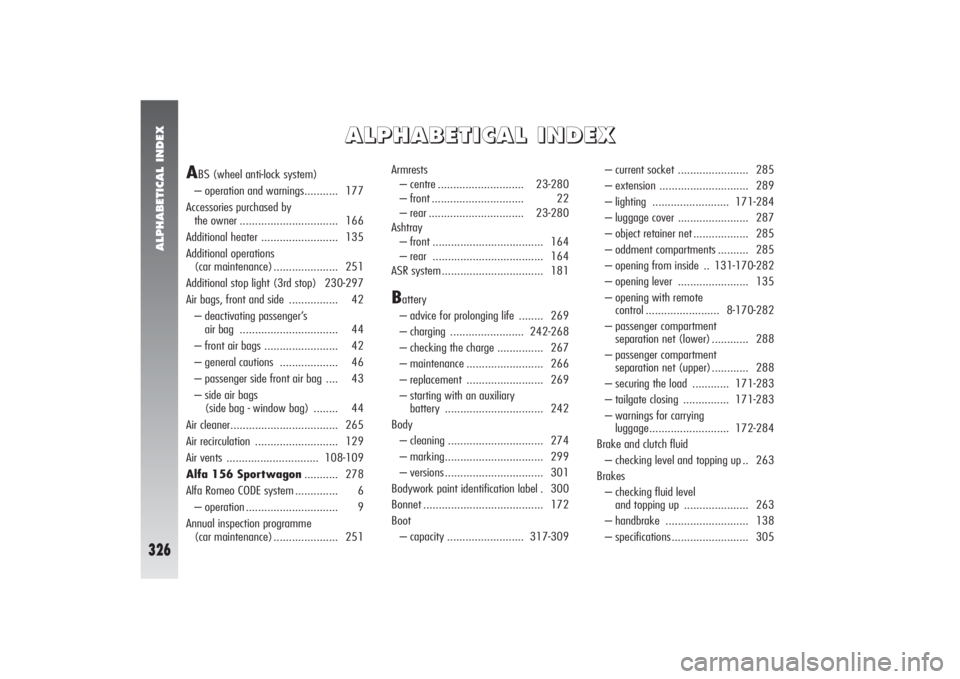
ALPHABETICAL INDEX
326
A A
L L
P P
H H
A A
B B
E E
T T
I I
C C
A A
L L
I I
N N
D D
E E
X X
A
BS (wheel anti-lock system)
– operation and warnings........... 177
Accessories purchased by
the owner ................................ 166
Additional heater ......................... 135
Additional operations
(car maintenance) ..................... 251
Additional stop light (3rd stop) 230-297
Air bags, front and side ................ 42
– deactivating passenger’s
air bag ................................ 44
– front air bags ........................ 42
– general cautions ................... 46
– passenger side front air bag .... 43
– side air bags
(side bag - window bag) ........ 44
Air cleaner................................... 265
Air recirculation ........................... 129
Air vents .............................. 108-109
Alfa 156 Sportwagon........... 278
Alfa Romeo CODE system .............. 6
– operation .............................. 9
Annual inspection programme
(car maintenance) ..................... 251Armrests
– centre ............................ 23-280
– front .............................. 22
– rear ............................... 23-280
Ashtray
– front .................................... 164
– rear .................................... 164
ASR system ................................. 181
Battery
– advice for prolonging life ........ 269
– charging ........................ 242-268
– checking the charge ............... 267
– maintenance ......................... 266
– replacement ......................... 269
– starting with an auxiliary
battery ................................ 242
Body
– cleaning ............................... 274
– marking................................ 299
– versions ................................ 301
Bodywork paint identification label . 300
Bonnet ....................................... 172
Boot
– capacity ......................... 317-309– current socket ....................... 285
– extension ............................. 289
– lighting ......................... 171-284
– luggage cover ....................... 287
– object retainer net .................. 285
– oddment compartments .......... 285
– opening from inside .. 131-170-282
– opening lever ....................... 135
– opening with remote
control ........................ 8-170-282
– passenger compartment
separation net (lower) ............ 288
– passenger compartment
separation net (upper)............ 288
– securing the load ............ 171-283
– tailgate closing ............... 171-283
– warnings for carrying
luggage.......................... 172-284
Brake and clutch fluid
– checking level and topping up .. 263
Brakes
– checking fluid level
and topping up ..................... 263
– handbrake ........................... 138
– specifications ......................... 305
Page 332 of 357
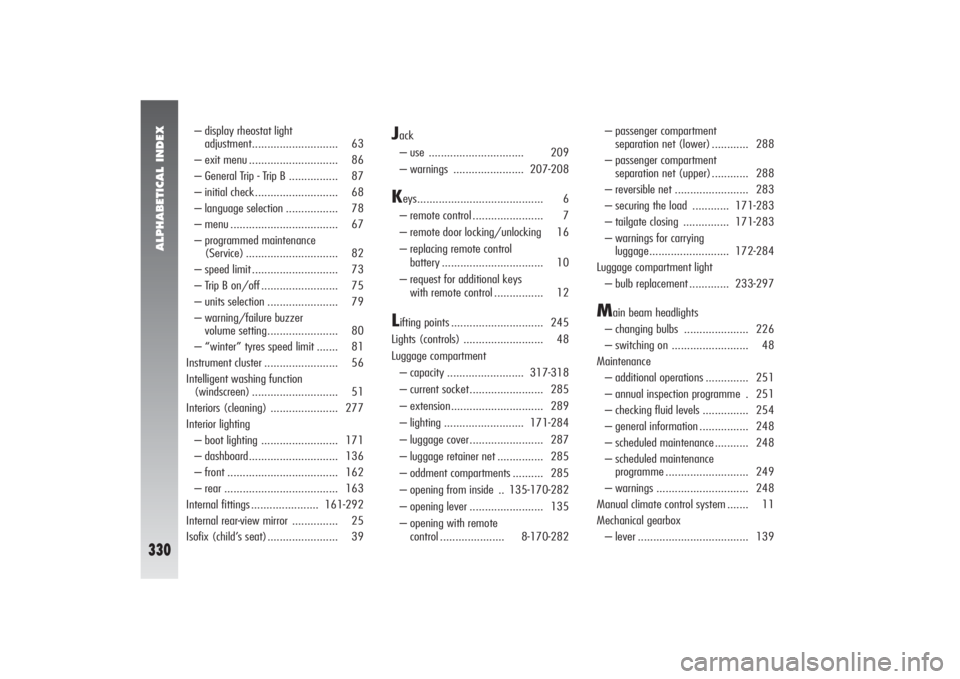
ALPHABETICAL INDEX
330
– display rheostat light
adjustment............................ 63
– exit menu ............................. 86
– General Trip - Trip B ................ 87
– initial check........................... 68
– language selection ................. 78
– menu ................................... 67
– programmed maintenance
(Service) .............................. 82
– speed limit ............................ 73
– Trip B on/off ......................... 75
– units selection ....................... 79
– warning/failure buzzer
volume setting....................... 80
– “winter” tyres speed limit ....... 81
Instrument cluster ........................ 56
Intelligent washing function
(windscreen) ............................ 51
Interiors (cleaning) ...................... 277
Interior lighting
– boot lighting ......................... 171
– dashboard............................. 136
– front .................................... 162
– rear ..................................... 163
Internal fittings ...................... 161-292
Internal rear-view mirror ............... 25
Isofix (child’s seat)....................... 39
Jack
– use ............................... 209
– warnings ....................... 207-208K
eys......................................... 6
– remote control ....................... 7
– remote door locking/unlocking 16
– replacing remote control
battery ................................. 10
– request for additional keys
with remote control ................ 12
Lifting points .............................. 245
Lights (controls) .......................... 48
Luggage compartment
– capacity ......................... 317-318
– current socket........................ 285
– extension.............................. 289
– lighting .......................... 171-284
– luggage cover........................ 287
– luggage retainer net ............... 285
– oddment compartments .......... 285
– opening from inside .. 135-170-282
– opening lever ........................ 135
– opening with remote
control ..................... 8-170-282– passenger compartment
separation net (lower) ............ 288
– passenger compartment
separation net (upper)............ 288
– reversible net ........................ 283
– securing the load ............ 171-283
– tailgate closing ............... 171-283
– warnings for carrying
luggage.......................... 172-284
Luggage compartment light
– bulb replacement ............. 233-297
M
ain beam headlights
– changing bulbs ..................... 226
– switching on ......................... 48
Maintenance
– additional operations .............. 251
– annual inspection programme . 251
– checking fluid levels ............... 254
– general information ................ 248
– scheduled maintenance ........... 248
– scheduled maintenance
programme ........................... 249
– warnings .............................. 248
Manual climate control system ....... 11
Mechanical gearbox
– lever .................................... 139
Page 356 of 357
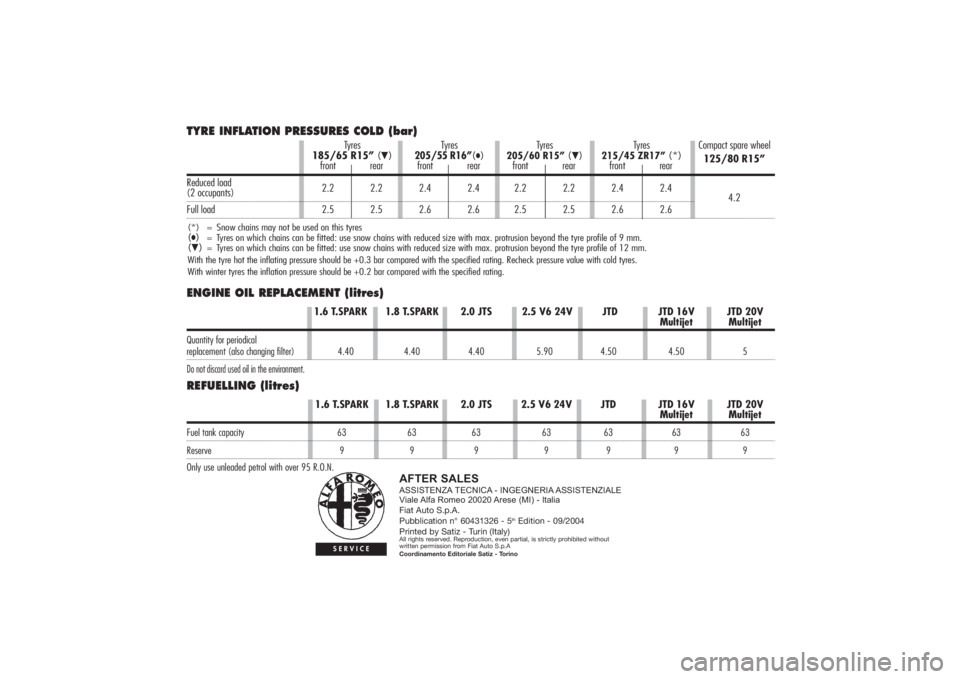
AFTER SALESASSISTENZA TECNICA - INGEGNERIA ASSISTENZIALE
Viale Alfa Romeo 20020 Arese (MI) - Italia
Fiat Auto S.p.A.
Pubblication n° 60431326 - 5
thEdition - 09/2004
Printed by Satiz - Turin (Italy)
All rights reserved. Reproduction, even partial, is strictly prohibited without
written permission from Fiat Auto S.p.A
Coordinamento Editoriale Satiz - Torino
SERVICE
REFUELLING (litres)Only use unleaded petrol with over 95 R.O.N.
1.6 T.SPARK 1.8 T.SPARK 2.0 JTS 2.5 V6 24V JTD JTD 16V JTD 20V
Multijet Multijet
Fuel tank capacity 63 63 63 63 63 63 63Reserve 9 9 9 9 9 9 9TYRE INFLATION PRESSURES COLD (bar) (*) = Snow chains may not be used on this tyres(●)= Tyres on which chains can be fitted: use snow chains with reduced size with max. protrusion beyond the tyre profile of 9 mm.
(▼)= Tyres on which chains can be fitted: use snow chains with reduced size with max. protrusion beyond the tyre profile of 12 mm.
With the tyre hot the inflating pressure should be +0.3 bar compared with the specified rating. Recheck pressure value with cold tyres.
With winter tyres the inflation pressure should be +0.2 bar compared with the specified rating.
ENGINE OIL REPLACEMENT (litres)
Tyres
185/65 R15”
(▼)
front rear
2.2 2.2
2.5 2.5Tyres
205/55 R16”
(●)
front rear
2.4 2.4
2.6 2.6Tyres
205/60 R15”
(▼)
front rear
2.2 2.2
2.5 2.5Tyres
215/45 ZR17”
(*)
front rear
2.4 2.4
2.6 2.6
Compact spare wheel
125/80 R15”
4.2
Reduced load(2 occupants)Full load
1.6 T.SPARK 1.8 T.SPARK 2.0 JTS 2.5 V6 24V JTD JTD 16V JTD 20V
Multijet Multijet
Quantity for periodical replacement (also changing filter) 4.40 4.40 4.40 5.90 4.50 4.50 5Do not discard used oil in the environment.